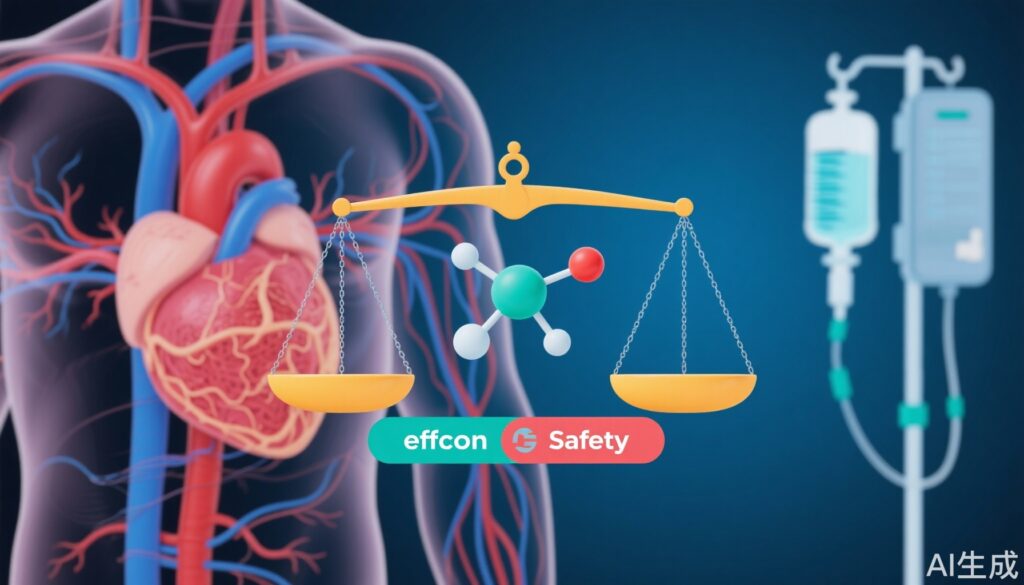Highlights
- The ACHIEVE trial, a large multinational RCT, found no reduction in cardiovascular mortality or heart failure hospitalization with spironolactone 25 mg daily in maintenance dialysis patients.
- Other contemporary trials (e.g., ALCHEMIST) and meta-analyses corroborate the lack of benefit on major cardiovascular events despite potential cardiac remodeling effects in related populations.
- Spironolactone is generally safe when carefully monitored but associated with increased risk of mild to moderate hyperkalemia in dialysis patients.
- Future research should explore non-steroidal mineralocorticoid receptor antagonists or alternative pathways for cardiovascular morbidity reduction in dialysis-dependent chronic kidney disease.
Background
Patients with end-stage kidney disease (ESKD) undergoing maintenance dialysis face exceptionally high cardiovascular morbidity and mortality rates, largely due to complex pathophysiology including volume overload, vascular calcification, left ventricular hypertrophy, and fibrosis. Mineralocorticoid receptor antagonists (MRAs) like spironolactone have proven cardiovascular benefits in heart failure populations by attenuating aldosterone-driven fibrosis and remodeling. However, their efficacy and safety in dialysis populations remain uncertain because these patients were often excluded from major randomized trials due to heightened hyperkalemia risk and altered pharmacokinetics.
Key Content
Chronological Development of Evidence
Early small trials and meta-analyses up to 2016 suggested that MRAs could reduce all-cause and cardiovascular mortality and improve left ventricular mass index in dialysis patients, though with increased hyperkalemia risk (Karim et al., 2016; Chang et al., 2019). However, these studies had limitations including small sample sizes and methodological heterogeneity.
The SPin-D trial (2018) tested escalating doses (12.5 mg to 50 mg) of spironolactone in hemodialysis patients and found no major benefit on echocardiographic parameters but noted hyperkalemia predominately at the highest dose. Similar findings were reported by Nakamura et al. (2019) in a placebo-controlled trial showing no significant LV mass reduction but better safety at moderate dosing.
Large-scale, definitive RCTs published in 2025 have provided critical insights:
1. ACHIEVE Trial: An international, parallel-group RCT enrolling 2,538 dialysis patients tolerating spironolactone 25 mg daily in an open-label run-in, randomized to continue spironolactone or placebo. Over median 1.8 years, spironolactone failed to reduce the composite of cardiovascular death or heart failure hospitalisation (HR 0.92, 95% CI 0.78–1.09; p=0.35) or all-cause mortality. The study was stopped early for futility (Walsh et al., 2025).
2. ALCHEMIST Trial: A similar endpoint, event-driven RCT in haemodialysis patients at high cardiovascular risk across France, Belgium, and Monaco. Spironolactone at up to 25 mg/day showed no reduction in primary cardiovascular outcomes compared to placebo, confirming ACHIEVE findings (Walsh et al., 2025).
An updated meta-analysis incorporating these trials reinforced that steroidal MRAs do not reduce cardiovascular events or mortality in maintenance dialysis patients. The risk of hyperkalemia remains present but manageable with monitoring.
Mechanistic and Translational Insights
Although the large RCTs failed to demonstrate clinical event reduction, subgroup and smaller studies such as the MAGMA trial in patients with type 2 diabetes and CKD (non-dialysis) exhibited spironolactone-mediated regression of left ventricular mass, reduced aortic wall volume, and decreased myocardial fibrosis markers, implying mechanistic benefits in earlier CKD stages.
Proteomic analyses from the HOMAGE trial and others show spironolactone’s effect on reducing fibrosis-related biomarkers (MMP-2, NT-proBNP), independent of left atrial size or volume (2024). This suggests that in pre-dialysis or less severe CKD patients, MRAs may ameliorate underlying myocardial remodeling, whereas in end-stage renal disease requiring dialysis, irreversible cardiovascular damage limits clinical impact.
Safety Considerations
Monitoring for hyperkalemia is crucial, as studies (e.g., SPin-D, AMBER trial) show increased hyperkalemia frequency with spironolactone but rarely requiring permanent discontinuation. Bradyarrhythmias have been reported but not definitively confirmed to increase mortality. Co-administration of potassium binders (patiromer) permits more persistent spironolactone use in CKD, though not yet robustly evaluated in dialysis settings.
Expert Commentary
The ACHIEVE and ALCHEMIST trials decisively address a long-standing clinical question on initiating spironolactone in maintenance dialysis patients. Despite promising surrogate endpoint data and favorable cardiac remodeling observed in non-dialysis CKD, the lack of demonstrated benefit in hard outcomes in dialysis patients underscores the need for caution in extrapolating benefits across CKD stages.
These findings challenge clinical practice that has occasionally favored off-label use of MRAs in dialysis, emphasizing instead the risks of hyperkalemia and uncertain efficacy. It prompts reconsideration of aldosterone pathways as therapeutic targets in advanced renal failure, perhaps favoring novel non-steroidal MRAs or combinational therapies targeting oxidative stress and inflammation.
Notably, the homogeneous absence of benefit across diverse dialysis populations, despite large sample sizes and rigorous design, demonstrate that cardiovascular morbidity in ESKD is multi-factorial with mechanisms beyond aldosterone-mediated myocardial fibrosis. Moreover, future research should leverage biomarker-driven phenotyping to identify potential responders or earlier intervention windows.
Conclusion
The ACHIEVE trial and supporting evidence conclusively demonstrate that spironolactone at 25 mg daily does not reduce cardiovascular mortality or hospitalizations for heart failure in maintenance dialysis patients. While MRAs have mechanistic benefits in less advanced CKD, they fail to translate into improved hard outcomes once dialysis is initiated.
Current guidelines should integrate these findings, discouraging routine MRA initiation in dialysis unless future evidence proves otherwise. Monitoring and management of hyperkalemia remain paramount when MRAs are used.
Future clinical research should explore newer mineralocorticoid receptor antagonists with potentially improved safety profiles, and alternative strategies targeting the complex cardiovascular pathology of dialysis-dependent ESKD.
References
- Walsh M, Collister D, Gallagher M, et al.; ACHIEVE Investigators. Spironolactone versus placebo in patients undergoing maintenance dialysis (ACHIEVE): an international, parallel-group, randomised controlled trial. Lancet. 2025;406(10504):695-704. doi:10.1016/S0140-6736(25)01198-5. PMID: 40818850.
- Walsh M et al. Spironolactone in patients on chronic haemodialysis at high risk of adverse cardiovascular outcomes (ALCHEMIST): a multicentre, double-blind, randomised, placebo-controlled trial and updated meta-analysis. Lancet. 2025;406(10504):705-718. doi:10.1016/S0140-6736(25)01194-8. PMID: 40818851.
- Chang TI et al. Safety evaluation and cardiovascular effect of additional use of spironolactone in hemodialysis patients: a meta-analysis. Drug Des Devel Ther. 2019;13:1487-1499. doi:10.2147/DDDT.S189454. PMID: 31118582.
- Nakamura T et al. A randomized controlled trial of the effect of spironolactone on left ventricular mass in hemodialysis patients. Kidney Int. 2019;95(4):983-991. doi:10.1016/j.kint.2018.11.025. PMID: 30712923.
- Fang Y et al. Long-Term Effects of Low-Dose Spironolactone on Chronic Dialysis Patients: A Randomized Placebo-Controlled Study. J Clin Hypertens (Greenwich). 2016;18(2):121-128. doi:10.1111/jch.12628. PMID: 26224543.
- Stewart J et al. The Safety and Efficacy of Mineralocorticoid Receptor Antagonists in Patients Who Require Dialysis: A Systematic Review and Meta-analysis. Am J Kidney Dis. 2016;68(4):591-598. doi:10.1053/j.ajkd.2016.04.011. PMID: 27265777.



